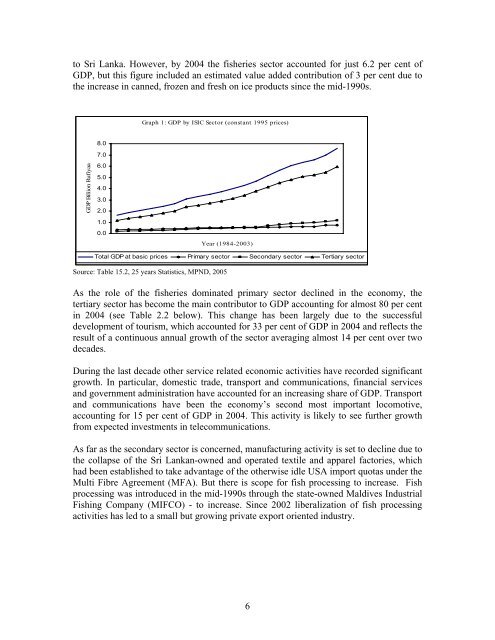DTIS, Volume I - Enhanced Integrated Framework (EIF)
DTIS, Volume I - Enhanced Integrated Framework (EIF)
DTIS, Volume I - Enhanced Integrated Framework (EIF)
Create successful ePaper yourself
Turn your PDF publications into a flip-book with our unique Google optimized e-Paper software.
to Sri Lanka. However, by 2004 the fisheries sector accounted for just 6.2 per cent of<br />
GDP, but this figure included an estimated value added contribution of 3 per cent due to<br />
the increase in canned, frozen and fresh on ice products since the mid-1990s.<br />
Graph 1: GDP by ISIC Sector (constant 1995 prices)<br />
8.0<br />
7.0<br />
GDP Biliion Rufiyaa<br />
6.0<br />
5.0<br />
4.0<br />
3.0<br />
2.0<br />
1.0<br />
0.0<br />
Year (1984-2003)<br />
Total GDP at basic prices Primary sector Secondary sector Tertiary sector<br />
Source: Table 15.2, 25 years Statistics, MPND, 2005<br />
As the role of the fisheries dominated primary sector declined in the economy, the<br />
tertiary sector has become the main contributor to GDP accounting for almost 80 per cent<br />
in 2004 (see Table 2.2 below). This change has been largely due to the successful<br />
development of tourism, which accounted for 33 per cent of GDP in 2004 and reflects the<br />
result of a continuous annual growth of the sector averaging almost 14 per cent over two<br />
decades.<br />
During the last decade other service related economic activities have recorded significant<br />
growth. In particular, domestic trade, transport and communications, financial services<br />
and government administration have accounted for an increasing share of GDP. Transport<br />
and communications have been the economy’s second most important locomotive,<br />
accounting for 15 per cent of GDP in 2004. This activity is likely to see further growth<br />
from expected investments in telecommunications.<br />
As far as the secondary sector is concerned, manufacturing activity is set to decline due to<br />
the collapse of the Sri Lankan-owned and operated textile and apparel factories, which<br />
had been established to take advantage of the otherwise idle USA import quotas under the<br />
Multi Fibre Agreement (MFA). But there is scope for fish processing to increase. Fish<br />
processing was introduced in the mid-1990s through the state-owned Maldives Industrial<br />
Fishing Company (MIFCO) - to increase. Since 2002 liberalization of fish processing<br />
activities has led to a small but growing private export oriented industry.<br />
6
















